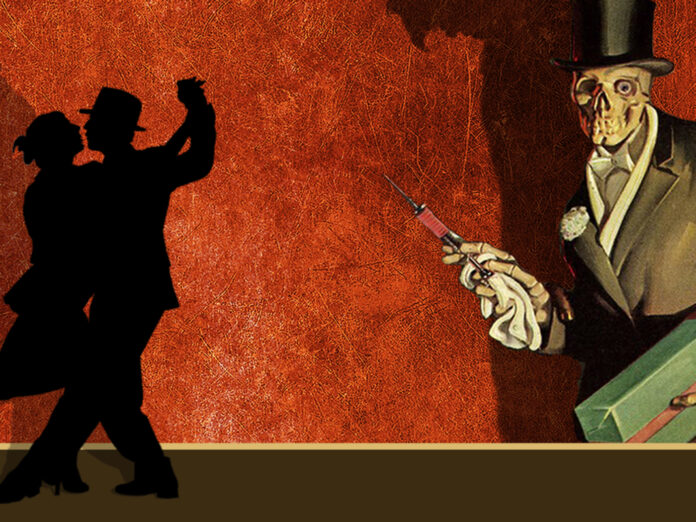The waiting gear has hardly changed since 1966. Jim Keltner’s drumkit looks Ringo-minimal behind the piano, guitars and upright bass scattered beneath Old Hollywood Klieg lights, the basic materiel of a mid-20th century roadhouse touring band – the Hawks, say. And when those lights go up, a gold-jacketed electric guitarist sits in the band’s half-circle with his straight back enigmatically to us, as if cooking up tunes in an after-hours joint, not the Albert Hall. Then Bob Dylan turns to the piano, Keltner’s bass-drum whomps, and “All Along The Watchtower” gradually coalesces.
The waiting gear has hardly changed since 1966. Jim Keltner’s drumkit looks Ringo-minimal behind the piano, guitars and upright bass scattered beneath Old Hollywood Klieg lights, the basic materiel of a mid-20th century roadhouse touring band – the Hawks, say. And when those lights go up, a gold-jacketed electric guitarist sits in the band’s half-circle with his straight back enigmatically to us, as if cooking up tunes in an after-hours joint, not the Albert Hall. Then Bob Dylan turns to the piano, Keltner’s bass-drum whomps, and “All Along The Watchtower” gradually coalesces.
Dylan’s casual return to guitar to open the first few songs tonight – his precise contribution hard to extract from Doug Lancio and Bob Britt’s interweaving – is one of several rebuttals to the passing of time. When I saw the second European night of the now epic Rough And Rowdy Ways tour in a gloomy Stockholm arena in 2022, Dylan, then 81, stood only occasionally and, it seemed, shakily. The three-year tour he’d announced to showcase his new songs seemed quixotically optimistic then. Yet tonight he starts most songs standing among his compadres before leaning conspiratorially on the piano, apparently stronger now than when he started, rejuvenated even.
READ OUR REVIEW OF BOB DYLAN LIVE AT USHER HALL, EDINBURGH, NOVEMBER 5, 2024
Many other things have changed at the venue where Dylan first, famously, appeared in ’65 before returning in 2013 with the reborn voice and stable setlists which have radically transformed the last decade’s iteration of the Never-Ending Tour. Alongside Rough And Rowdy Ways songs which have evolved far beyond the album, the breezy, minor back-catalogue which studded his 2022 UK visit has been replaced by heavy ‘60s hitters, in a powerfully rebalanced set.
“It Ain’t Me, Babe” follows “Watchtower”. “It sure ain’t me, babe,” Dylan sings, words ringing out over a minimalist piano jangle which veers into avant-garde pathways, till Keltner steers back to firm ground. “I play Beethoven… and Chopin,” Bob adds on “I Contain Multitudes”, but his sometimes discordant piano strays closer to jazz, where Keltner follows him with delicate attentiveness, running the ship between them.
This is also often the closest Dylan has been to rock for many years. His piano shoots “False Prophet” somewhere tumultuous, Keltner essays stormy rolls,and Britt’s lightning-bolt guitar recalls the sound made by Robbie Robertson here a lifetime ago. There’s an Elvis shiver to his vocal on “When I Paint My Masterpiece”, Dylan’s harmonica solo echoing in from Oh Mercy’s swamps and followed by dark, slow stride piano. Britt’s fuzzed chords drop like controlled explosions into the heavy blues of “Crossing The Rubicon”, as Dylan considers heroes of his youth from Martin Luther King to Montgomery. The vigorous sound he’s plugged back into hilariously climaxes with “Desolation Row”. Students of his hide-and-seek chorus from “Like A Rolling Stone” circa 2019 will surely place this still higher among his iconoclastic rearrangements. Verses are hurled overboard to permit rocketing Rawhide rockabilly, Keltner’s rumbling toms maintaining the relentless pace, till Dylan’s final piano solo pulls the sound still tighter in this wild new place.
Dylan moves directly from this legendary address to “Key West”, a Rough And Rowdy Ways song of equal majesty. It’s an example of tonight’s other dominant mode, with Dylan’s voice and words front and centre, and the band in barely perceptible support. The song hangs suspended outside time, adjacent to its mystical Florida “horizon line”, as Dylan lays out lines with quiet inevitability. He swallowed words early in the show, but now every phrase, and his pride in them, is clear.
A little earlier, “My Own Version Of You” was revealed as another of his great epics in similar Bob-centric fashion. “I say to hell with all things that used to be,” he snarls during this Frankenstein tale like no song he or anyone has written before. “I can see the whole history of the human race…on your face,” he adds with relish, and you believe him. “It’s All Over Now Baby Blue” begins with a dramatic, stark vocal flourish and clarion power, as Dylan plays sad cantina piano. His consistency of purpose and achievement across his whole career is set in relief by these past and present songs.
Along with pride in his songs and performance, there’s a modesty to Dylan and his band, heard in the way they vanish into the jump-blues drive of “Goodbye Jimmy Reed”, as infinitely timeless in its own way as “Key West”. Teenage Bob’s ambition was to join Little Richard’s band. Here for a few minutes, he has.
Dylan stands to preach “Every Grain Of Sand”, a Blakean prayer written by a Bob hitting 40 and hovering between faith and doubt, when “sometimes I turn, there’s someone there, other times it’s only me.” He hits mighty gospel chords, then plays a harmonica solo whose giant, reverberating notes fill the hall. It might be the last time for all this one day. But not yet.
Bob Dylan and his band setlist Royal Albert Hall, November 13, 2024:
All Along The Watchtower
It Ain’t Me Babe
I Contain Multitudes
False Prophet
When I Paint My Masterpiece
Black Rider
My Own Version Of You
Crossing The Rubicon
Desolation Row
Key West (Philosopher Pirate)
Watching The River Flow
It’s All Over Now, Baby Blue
I’ve Made Up My Mind To Give Myself To You
Mother Of Muses
Goodbye Jimmy Reed
Every Grain Of Sand



